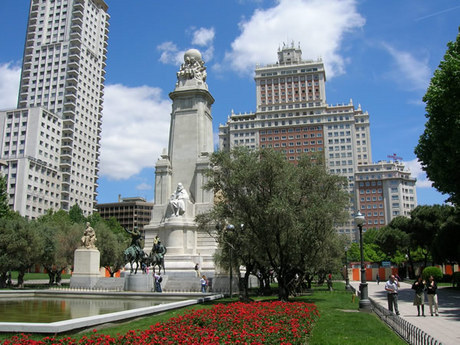Plaza de España
Plaza de España is a large square and popular tourist destination, located in central Madrid, Spain, at the western end of the Gran Vía. It features a monument to Miguel de Cervantes Saavedra, and is bordered by two of Madrid's most prominent skyscrapers. Also, the Palacio Real (Royal Palace) is a short walk south from the plaza.
Located close to the Palacio Real (Royal Palace), the site was occupied by barrack. After it was demolished, a new public square was created. It became a popular meeting place in the 1950s, after two of Madrid's largest buildings were constructed: the Edificio de España and the Torre de Madrid. Both buildings were constructed by the project developer Metropolitana and designed by the Otamendi brothers. In 1808, the area was part of the Principe Pío hill. It was one of the locations used by the French firing squads to execute prisoners taken during the May 2nd uprising.
In the center of the plaza is a monument to Spanish novelist, poet and playwright Miguel de Cervantes Saavedra, designed by architects Rafael Martínez Zapatero and Pedro Muguruza and sculptor Lorenzo Coullaut Valera. Most of the monument was built between 1925 and 1930. It was finished between 1956 and 1957 by Federico Coullaut-Valera Mendigutia, the son of the original sculptor.
Madrid's main avenue, the Gran Via, ends at the Plaza de España, one of the city's busiest traffic intersections. It is a square featuring a large fountain and a monument to Cervantes, the great figure of Spanish literature known for writing "Don Quixote".
A sculpture of Cervantes overlooks that fictional character in a bronze statue that also depicts Sancho Panza, who was Don Quixote's squire in the novel. Don Quixote's sweetheart Dulcinea is found on the left-hand side.
The tower portion of the monument includes a stone sculpture of Cervantes, which overlooks bronze sculptures of Don Quixote and Sancho Panza. Next to the tower, there are two stone representations of Don Quixote's "true love", one as the simple peasant woman Aldonza Lorenzo, and one as the beautiful, imaginary Dulcinea del Toboso.
Two of the city's largest buildings are found adjacent to the plaza, the Torre de Madrid (with its height of 142 metres, for a while the tallest concrete structure in Europe) and the "Edificio España", both dating from the 1950s.
The area right around Plaza de España holds a lively combination of art house movie theaters, ethnic restaurants and a large park, the Parque del Oeste. The southern section of the park, Templo de Debod, offers incredible sunset views overlooking the Almudena Cathedral and Royal Palace. The neighborhood northwest of Plaza de España, Argüelles/ Moncloa, is the city's biggest university district and holds all that comes with a student population: bars, concert venues, restaurants, clubs and numerous shops. You can get there via flight to Madrid.




